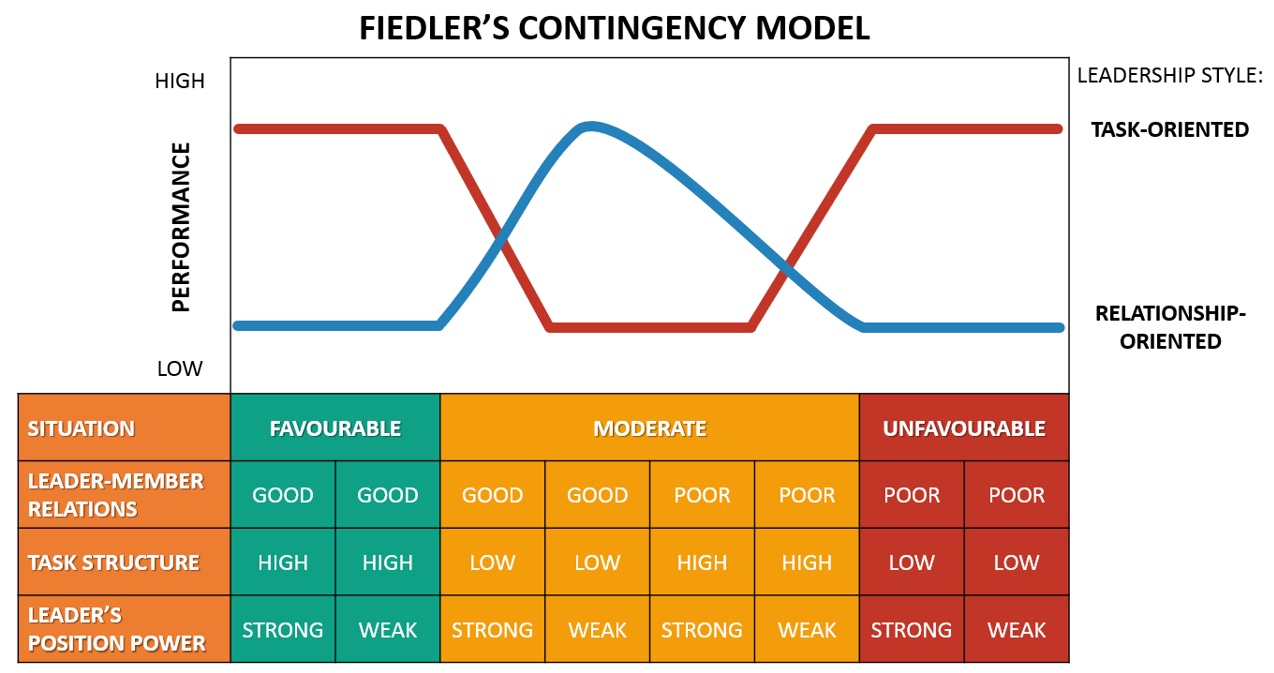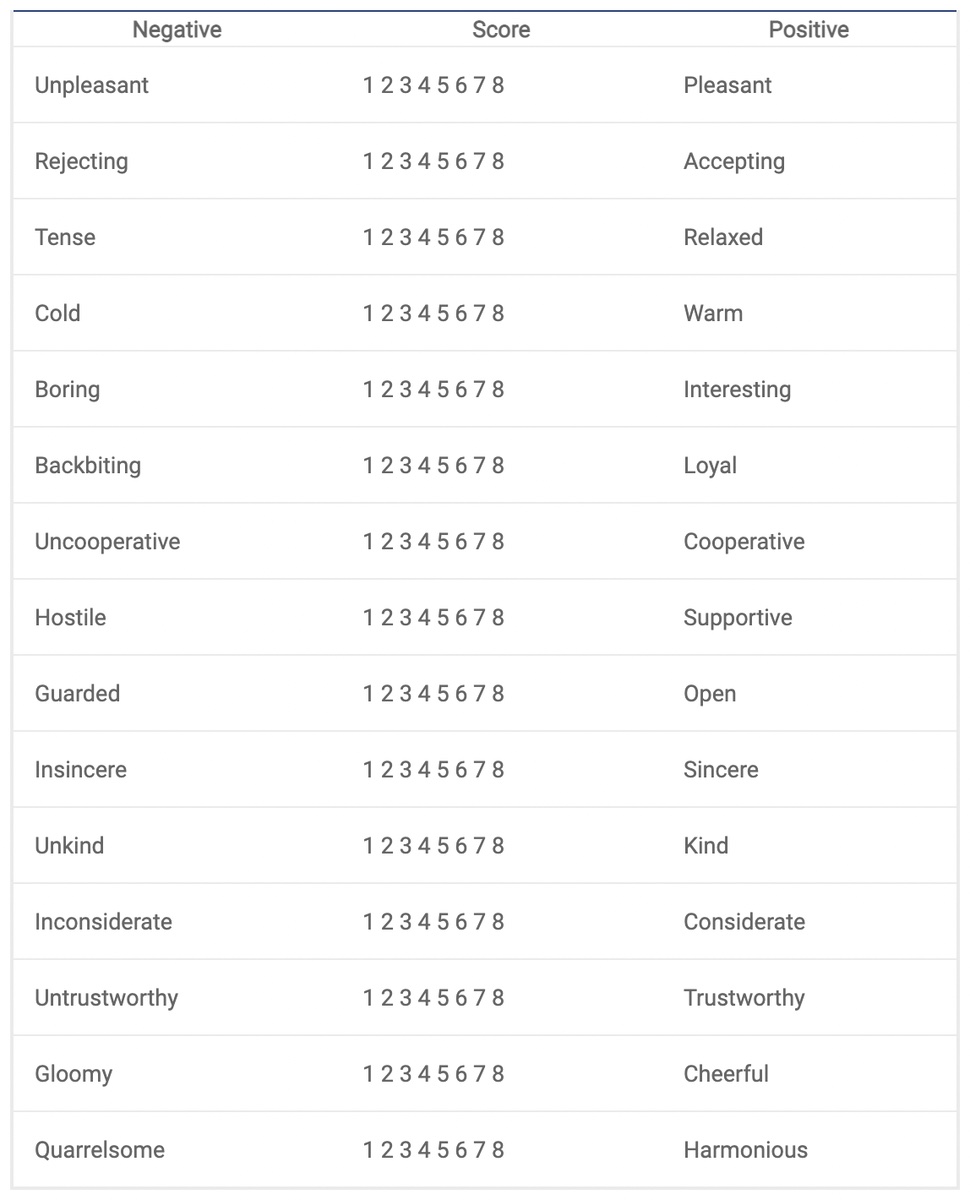Fiedler’s Contingency Model of Leadership is similar to Hersey and Blanchard’s Situational Leadership Model and Blake and Mouton’s Managerial Grid.
Origin
Fiedler’s Contingency Concept is based on a theory developed in the mid-1960s by Austrian psychologist Professor Fred Fiedler after studying the personalities and characteristics of leaders.
He found that a leader’s readiness level came down to two things:
- Natural leadership style
- Situational favorableness
The Model
Like the behavioral approaches to leadership, this model asserts that there is no one best leadership style. Instead, a leader’s success is contingent on (or dependent on, as the case may be): the situation (Contingency Theory). However, in contrast to Hersey and Blanchard, Fiedler looked more at the specifics of the situation in order to determine the best leadership style.

Fiedler Contingency Model
In addition, Fiedler was of the opinion that individuals’ inherent leadership styles are fixed and cannot be altered. Either changing the situation to suit the leader or changing the leader themselves is the most effective way to handle the situation.
LPC Scale
Fiedler identified two different styles of leadership behaviour based on a test called the Least Preferred Coworker (LPC) scale.

Least Preferred Coworker Scale
Leaders consider the person with whom they would prefer to work least. Then, they rank their least preferred coworker on a scale of 1 to 8 based on a variety of factors.
You are considered a high LPC leader if you have a high score. This shows that you are a leader who values relationships. Your success at establishing relationships and resolving disagreements exemplifies the leadership style that best fits you. You are considered a low LPC or a task-oriented leader if your score is low. A strong capacity to organize teams and projects for greater efficiency and effective task completion is a hallmark of task-oriented leadership.
The rationale behind these two leadership styles is pretty straightforward:
- Rating your least preferred coworker favorably means that you see the best in people—even those who you wouldn’t necessarily choose to work with
- Rating your least preferred coworker unfavorably suggests that you struggle to see their contributions, since you value efficiency and effectiveness over other attributes
There isn’t one right way to lead. While task-orientation may be preferable to the organization at large, teammates themselves tend to prefer relationship-orientation.
Situational Variables
Fiedler identified three situational variables that were favorable, moderate, or unfavorable situation for leaders. These are the variables:
- Leader-Member Relations
- Task Structure, and
- Leader’s Position Power
Leader-Member Relations
This is the trust and confidence level a team has in its leader. A leader who is trusted and has more influence within the group is in a more favourable situation than a leader who is not trusted. Fiedler identifies leader-member relations as either good or poor.
Task Structure
This refers to the type of tasks the followers are expected to conduct. Tasks can be clear and well-structured or vague and unstructured. There is an unfavorouble situation if tasks are unstructured or if the team and the leader have little knowledge how to achieve certain tasks. Fiedler identifies task structure as either high or low.
Leader’s Position Power
This is the power a leader has to direct the group and provide reward or punishment. The more power a leader has, the more favourable the situation. According to French and Raven’s Bases Of Power, there are several sources of power such as coercive, expert or referent power. Fiedler identifies a leader’s position power as either strong or weak.
Match Leadership Styles To Situations
By combining the aforementioned situational variables, you can create a variety of leadership situations ranging from highly favourable to highly unfavourable (Figure 1). A favourable situation would typically be one where the leader-member relations are good, the tasks are clear and well-structured, and the leader has a strong power position. While examining the relationship between different situations and leadership styles, Fiedler found a certain pattern. The two leadership styles that Fiedler looked at are similar to those used by Blake and Mouton and are:
Task Orientation
These leaders direct followers towards goals, give instructions, spend time planning, emphasize deadlines and provide explicit schedules of work acitivities. They simply want to get the job done.
Fiedler discovered that the task-oriented leader performs best in a favourable situation. This is because everyone in the team gets along, the task is clear and structured, and the leader has sufficient power over followers. In such a situation, the team simply needs a leader that can provide direction.
Similarly, if the situation is highly unfavourable, the same leadership style is considered more effective than a relationship-oriented leader. This is because an unfavourable situation requires a leader that can offer a great deal of structure and direction due to the low presence of task structure.
Furthermore, since leader-members relations are poor anyway, a friendly relationship-oriented leader will make no difference in the leader’s popularity.
Examples of task-oriented leaders include:
- Project managers, who are responsible for leading teams to complete specific projects on time and within budget.
- Military commanders, who lead troops in battle and must make quick decisions under intense pressure.
- CEOs, who are responsible for leading companies to success through effective strategic planning and decision-making.
- Engineers, who lead product development teams, and focus on delivering the project on-time and on-budget
- Supervisors in production environments, who lead teams to achieve production goals, and maintain the quality and safety standards
- Science lab leaders, who lead teams of researchers in conducting experiments and achieving research goals
- Head coaches in sports teams, who lead teams to win games and competitions by developing and implementing effective strategies.
These leaders are typically well-organized, detail-oriented, and able to effectively plan and direct the efforts of their team to achieve specific objectives.
Relationship Orientation
These leaders are mindful of followers, respect their ideas and feelings, establish mutual trust, are friendly, provide open communication, develop teamwork, and are oriented toward their followers’ welfare. The relationship-oriented leader performs better in situations of moderate favourability.
In these situations, the leader may be moderately liked by the group, has some position power, and has to supervize tasks that are somewhat structured. Here, people skills are important in order to achieve group performance.
According to Fiedler, a leader with good interpersonal skills can create a positive group atmosphere that will improve leader-member relations, clarify tasks and create more structure, and establish a stronger position power.
Examples of relationship-oriented leaders include:
- Human resource managers, who focus on building and maintaining positive relationships with employees
- Mentors, who guide and support others in their professional and personal development
- Team leaders in collaborative environments, who focus on fostering a positive team dynamic and building trust among team members
- Community leaders, who work to bring people together and build strong relationships within a community
- Social workers, who help individuals and families navigate complex social issues and build positive relationships
- Priests, imams, or other religious leaders, who provide spiritual guidance and support to congregants
- Therapists, counselors, or coaches, who work to understand clients’ needs and build positive, supportive relationships to help them achieve their goals
- Non-profit leaders, who work to build relationships with donors and volunteers to support their causes
These leaders typically prioritize the well-being of their team members and create a positive and supportive work environment, encouraging collaboration and open communication.
Advantages
- The Fiedler’s Contingency Model is a straightforward guideline that will assist you in managing your own situational leadership. This not only helps you organize your lower-level managers and supervisors but also ensures that you are in the right place. 42% of leaders say they want a better way to assess strengths in leadership. You can assign leadership roles based on the current situation using this contingency model. Do you have a supervisor who is good at completing tasks but less personable? Put them in a bad situation and watch as they do well.
- The adaptability of this contingency theory is the second advantage. In the past, everyone knew there was only one way to manage. Based on the various circumstances, you are able to delegate leadership responsibilities to your supervisors using this theory. In addition, it lets you figure out where your leadership style fits best, allowing you to have the most positive impact on your team.
- Furthermore, as a situational leadership theory, it encourages you to recognize how the circumstances affect your ability to lead well. You can either work on your interpersonal relationship with your team or change the circumstances if your situational leadership is off. You could, for instance, include more mechanisms for two-way feedback or strengthen the task structure.
Most importantly, Fiedler’s theory suggests that a leader’s personality does not determine their effectiveness. This situational theory, on the other hand, proposes that individuals become supportive leaders when they are in an environment that is compatible with their various leadership styles.
Disadvantages
This theory is not without its flaws.
- The self-assessment’s inaccuracy is the first problem. Sadly, it’s easy to make inaccurate assessments of oneself. In a similar vein, you might give situational favorableness an incorrect ranking. Therefore, it is essential to involve your team.
- The second issue is that it is unclear what to do if your style is somewhere in the middle. Even though Fiedler advises choosing a style based on the situation, this might not be your natural tendency.
- Finally, if your leadership style doesn’t fit the situation and you can’t change it, this theory won’t help. It’s possible that you won’t be able to hire supervisors to help you and that you won’t be able to change the favor.




